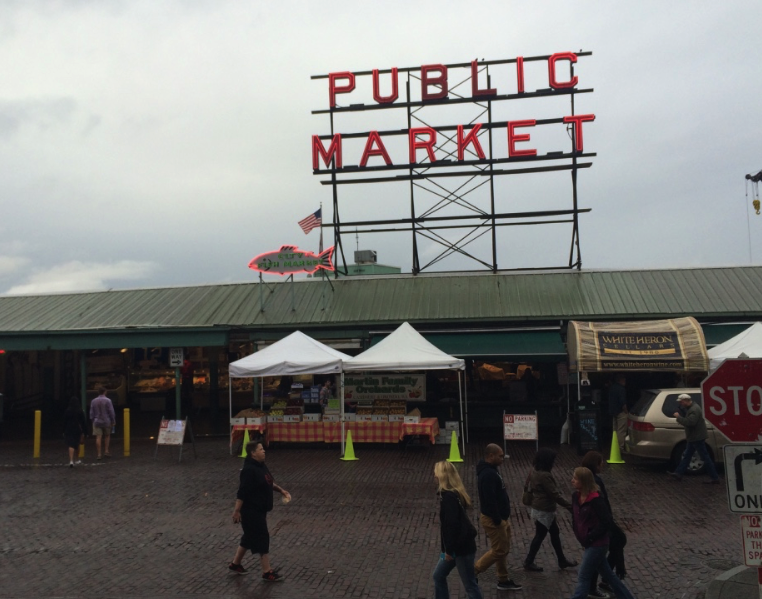A local tour of Seattle’s Pike Place Market

By EILEEN OGINTZ
SEATTLE, WA (DAY 3) — Who knew?
Certainly not the first farmers who decided to sell their produce at Pike Place Market in 1907 to avoid paying middlemen, selling directly to consumers at a more reasonable price. They never could have imagined that the market would be one of Seattle’s top tourist sites, attracting more than 10 million visitors a year.
We’ve signed on for Seattle’s only chef-led tour of the market with Elizabeth McClure’ new company Eat Seattle Tours. She also does cooking classes in the Market’s Atrium Kitchen, shopping with the students first for ingredients.
(Visiting Seattle in November or the winter can save you over $130 a night on a hotel room as compared to the summer months, according to the hotel megasearch site trivago.)
Certainly you can get everything you need here from spices (Market Spice has been supplying home cooks and chefs for generations), cheese (Beecher Cheese makes the cheese right here and the best mac and cheese I’ve ever tasted), fish (yes, this is where the fishmongers throw the big glistening salmons and never seem to drop them), butchers and produce, dried fruits and nuts…the list goes on and on.
McClure, a Cordon-Bleu trained chef who also went to business school, said she was inspired to start the company after traveling with her husband for a year in Europe, savoring markets and local foods. “It gave me a new appreciation for what the Northwest has to offer,” she said. “I wanted to share that.”
There are 10 stops on our two-hour tour and along the way, McClure whips out food she has made just that morning with ingredients from market purveyors—Chai profiteroles, onion tarts. She promises to email recipes.
We stop for coffee and vegan donuts at Local Color and samples of the cheese and mac and cheese at Beecher’s. We skip the line outside the original Starbucks. McClure explains that under the market charter, a stand or shop here must be the original or first and then it is fine to expand. Beecher’s, for example, now has a New York City shop, she said. She hands out the onion tarts at Frank’s Quality Produce which she said supplies many of Seattle’s restaurants. Smoked salmon is a treat at Pure Food Fish, now run by the fourth generation of the same family.
Pike Place Market is one of the oldest running farmers markets in the country and continues to advocate for the preservation of regional farmland. Sadly, many of the farmers before World War II were Japanese Americans who had to give up their farms and stands when they were forced into internment camps.
The market is part of a nine-acre Market Historic District created in 1971 by the City of Seattle to protect and preserve the neighborhood: The Pike Place Market Preservation and Development Authority are charged to increase the chances for farm and food retails and small businesses as well as to provide services to low-income Seattlites.
Today the market is home to over 500 small businesses–farmers, craftspeople, butchers, fish markets including one now run by the fourth generation (Pure Food Fish),bakeries, restaurants and specialty foods.
There are also 400 low income housing units above the store fronts, an active senior center (the Urban Garden here run by volunteers provides more than 400 pounds of produce a year), a clinic, food bank, Pike Market Child Care & Preschool and an assisted living facility for seniors in the heart of the Market community. The market mascots, big bronze pigs named Rachel and Billie, are actually piggy banks and major fund raisers for the Market Foundation.
It covers nine acres and is going to expand all the way down to the waterfront. Today more than 80 Washington farmers sell their produce and products at arket farm stalls seven days a week. (June-October, Pike Place Market operates four Express farmers markets in downtown too. The market is only closed on Thanksgiving and Christmas.)
McClure said she chose vendors to showcase on her tour who not only are local and independent but don’t use hormones or preservatives. Each had a story to tell.
The “Meet the Producer” is an important tradition here, whether you want to talk to a farmer about his apples or cider, a baker about her breads or an artisan making jewelry—they are happy to share their knowledge with you.
We sampled Uli’s German sausage. When the sausage-loving German moved to Seattle, he decided he couldn’t live without German sausage and decided to start a business here. Delicious!
There are 70 places to eat, whether you want chowder, a sandwich, sushi, frozen yogurt, Greek yogurt… some of the Market’s restaurants date back to the early 1900s while others are new.
You can also buy anything you might need… raw goat milk or crème fraiche, honey or jam, pheasant and other game birds, locally grown herb blends, flavored olive oil, truffle salt, ingredients for Middle Eastern, Caribbean and Mexican cooking.
Too bad I only have a carry-on bag.



